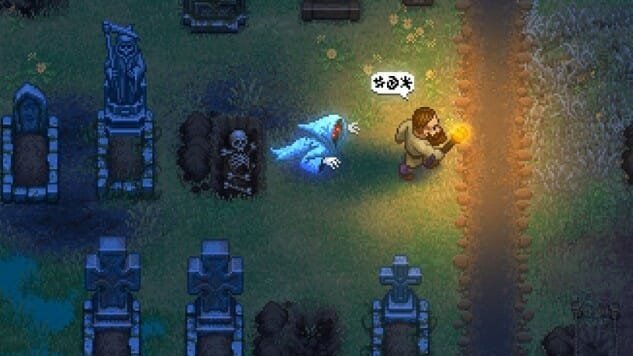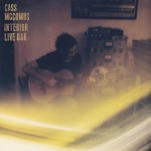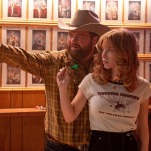A Beginner’s Guide to Graveyard Keeper

With only a month to go before the full release of Graveyard Keeper, it’s time to get a head start before the final build changes everything. Actually the alpha, which is available now to the public as part of an early access program, is a fairly substantial portion of the complete version of the game. There are some areas that are blocked off, character dialogues and missions that are currently closed, and items that cannot be seen or used yet in the skill tree. But the meat of the game is there, so whatever you learn now will still apply later.
I’ve compared Graveyard Keeper to Stardew Valley before and while the comparison is apt, I think Graveyard Keeper may actually be harder. There are a lot more items to build, and tracking down and preparing the necessary resources can be a laborious slog. That being said, if you know what you’re getting into and stride into the game with a sense of vision and focus, you’ll be fine. And this guide can help you get there.
Let’s start with the basics.
Home

In Graveyard Keeper, you will have three general areas where you will be building, the Farm, the Graveyard and the Church. The Graveyard and Church are the only ones whose score you have to worry about though, so we’ll get to that in a minute. Your homebase is where you’ll make all the machines and contraptions you’ll need to refine resources. The menu for these items is accessible through a drafting table/desk on the left wall of the outside of your home. As you progress through the Skill Tree, more machines will open up, allowing you to make more advanced items for other projects. Many have at least three tiers, with the most advanced machines requiring the least amount of materials while producing the highest yields.
You have a big yard to work with, but you’ll need to expand it as time goes on so you have room for everything (that option is available at the desk). If you’re not sure what you should be doing with your time, either go hunt for resources to stock in the yard, or find a machine you haven’t built yet.
The farm itself is spread out a bit; if you root around in the north and to the east, you’ll also find a beekeeping field and a vineyard, which need to be fixed up in order to use (and both require completion of certain Skill Tree entries). To the slight south of the house is also an area where you can grow crops and plants needed to maintain your energy or make materials needed in the game, for example, hemp for the production of rope. The system is much less complicated than, say, Stardew Valley and, after buying seeds from a local farmer, you should find it very easy to start up and maintain. Like other buildable areas, there’s a Blueprint Desk to get you started. Building a plot to plant seeds takes very little time. Some plots require stakes, some don’t, and you can build a compost pile where you can make your own fertilizer with crop waste (peat moss, the most basic fertilizer, can also be bought from a Village vendor). The vast majority of the game is focused on graveyard maintenance, not farming, so try to use it as a supplement to the entire experience rather than focusing on it specifically.
Inside the house is an area where you can prepare and cook food, as well as store some ingredients and items you might need in the process. Accessible through a trapdoor is a basement, where you’ll find storage room, as well as the remnants of several old barrels, which you can bust up for some scrap wood and Simple Iron Parts (which you should grab, because you won’t be able to make Simple Iron Parts right away, and they’re needed for many things). Eventually, you will be able to clear the rubble in certain areas of this section so that it opens up and is connected to the morgue, and to the basement underneath the church, which makes doing your cadaver and potion research a lot easier. You will be able to build things in these sections of the games too, including extra trunks, more cadaver tables, special machines for preparing ingredients, a writing desk, and more. More on that later.
Graveyard
Graveyard Keeper is basically a property management sim, and the graveyard is the most important part of the game. Every few days a donkey will come by the path outside your property and dump a corpse at the morgue. It has a decomposition rate and will begin to deteriorate in quality until it is collected and put on the autopsy table beneath the church (the doors to access this are right outside where the bodies are dumped). A bell will ring every time a body is dumped, and the amount it is allowed to decompose will play a part in the quality score of your graveyard, so be sure to get to it quickly.
The bodies will have more potential to provide points to your graveyard if they’ve been prepared first. Early on in the game, you won’t be able to do much but remove the blood and skin. The blood is used for elixirs and potions, so go ahead and toss those if you don’t have room for them in storage. The skin, however, is used for paper, and you’ll need a lot of that, so I suggest extracting and storing it. Later you’ll be able to also take out the heart, brain, intestines and body fat. The body fat is used for candles, which you need for the score of your Church, so be sure to hold onto that in particular. The body parts you take out of the cadaver will determine, somewhat, the quality of the corpse, which is gauged by a meter that displays a certain number of skulls. The red skulls on the meter are “bad” while the white ones are “good.” Removing the larger organs can have unpredictable results, but removing the blood and fat almost always removes one to two red skulls and improves the overall rating of the cadaver (if you’re unsure the effect your autopsy will have on the percentage, just quicksave and fool around until you get the hang of it, then reload the file). If you are able to get the corpse on the autopsy table while it is still in the 90% range of quality, then remove the blood and fat, the body should still be in good enough shape that you can get the most of it, points wise, when you bury it in the ground above.
The amount of white skulls on the rating of the corpse is very important because it determines the maximum value that any single grave can be “worth.” When you first arrive at the Graveyard, it is in very bad shape, and your first task is to clean it up and polish up the burial spots. Removing the debris and overgrowth will provide some property points, but you’ll need to go a step further and start building items like grave markers and grave fences. When applied to a burial spot, they will increase the score of the site, to a maximum of however many white skulls the cadaver had before it was buried. Use this to gauge the necessity of building additional markers, headstones and fences, some of which later are built with limited resources.
Once you have cleaned up the graveyard enough to impress the Episcop, who visits once a week, he will open the Church to you, and appoint you as its clergyman. You will then also have to manage the score of your Church in order to curry favor, build clout and prestige, and also earn money and Faith to continue your scientific research in the bowels of the Church’s underground.
Be aware that the graveyard does not have infinite space, and you can easily use up all the plots if you are not careful. This is especially bad because if you fill up the graveyard with “bad” (low score) bodies, you won’t be able to achieve the property score you need (apparently the bodies can be exhumed if you buy a deed, but I have not been able to get this to work, so it might be a final release feature). To slow the rate at which bodies are dropped, you can either keep them on your autopsy table, which will keep the corpse donkey at bay, or you can drop them into an open grave, which weirdly does not cause the body to deteriorate further, or affect your overall graveyard score (whereas if you cover them with dirt, it will both affect your score and cause the donkey to deliver another body). As a final option, you can also just dump the bodies in the river—so far the game does not seem to be keeping track of that or doling out any consequences, but it remains to be seen whether that will be the case in the final game.
Also be aware that if you build more autopsy tables for your bodies, the donkey will keep delivering cadavers enough to fill up those empty spots, so be sure there’s a corpse on each one if you’re trying to slow the drop rate.
Church

Like the Graveyard, the quality of your Church is determined by a score, and that score is built by manufacturing items that are integral to the maintenance of the facility—for example, pews, candelabras, an incense burner and a confession booth. There’s also a pulpit, where you can perform sermons. The attendance of these sermons will depend on the Church’s property score, and as more people show up, the more money and Faith are distributed at the end of the sermon. As time goes on and you unlock new abilities in the Skill Tree, you’ll be able to craft new sermons, with different effects and goals, which you can then perform for additional or different bonuses (for example, healthy crops).
Beneath the Church is your research area, known as the Alchemy Lab. The Study Table should be used frequently. It will require Faith, which you obtain from delivering sermons, and Science, which you can get by “researching” blank pieces of paper made from human skin. On each item in the game is a small descriptor window that will show one (or a combination) of three gems: red, green or blue. These gems indicate what the purpose of the item is (red is for building, green is for nature, and blue is for Faith/religious objects), but they also tell you what types of gems you will receive if you research the item on your table. The gems are then used to purchase new abilities in the Skill Tree. Progression in Graveyard Keeper is based on this specific process, so be constantly on the lookout for items that you have not yet researched. A fourth gem, purple, is not available in the Alpha build.
As for the other equipment in this area, you can craft the Alchemy Lab’s Blueprint Desk to make stuff like a Hand Mixer, Alchemy Workbench, Alchemy Mill, Distillation Cube and other machines meant to help you with vital elixirs and potions, including embalming fluids for your cadavers, and high quality fertilizer for your crops. However, don’t feel pressure to rush to get there all at once; it will take you some time before you can build all these items, much less their products in any meaningful way.
-

-

-

-

-

-

-

-

-

-

-

-

-

-

-

-

-

-

-

-

-

-

-

-

-

-

-

-

-

-

-

-

-

-

-

-

-

-

-

-










































